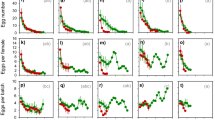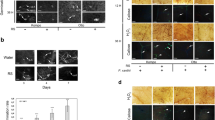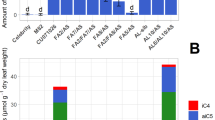Abstract
Pests are major constraints to increased cowpea production in tropical subsistence agriculture where cash inputs are small. Breeding for pest resistance is therefore the major component of pest management strategies for crop improvement. Of paramount economic importance among these pests are flower thrips [Megalurothrips sjostedti (Tryb.)] which may cause abscission of flower buds, flowers and peduncles, leading to seed yield losses of up to 100% (refs 1, 2). It has been difficult to use available sources of moderate thrips resistance in a breeding programme because of thrips variation in time and space in field screening3. This paper reports that ethylene is produced when thrips infest cowpea peduncles. We have used this fact to develop a screening technique using the synthetic growth regulator ethephon (2-chloroethylphosphonic acid), which when sprayed on the plant is translocated to actively-growing tissue, where it breaks down to form ethylene4–6. Cultivars susceptible to abscission caused by thrips also show increased abscission with ethephon treatment. The technique may be useful in identifying sources of resistance to other abscission-causing agents.
This is a preview of subscription content, access via your institution
Access options
Subscribe to this journal
Receive 51 print issues and online access
$199.00 per year
only $3.90 per issue
Buy this article
- Purchase on Springer Link
- Instant access to full article PDF
Prices may be subject to local taxes which are calculated during checkout
Similar content being viewed by others
References
Singh, S. R. & Allen, D. J. in Advances in Legume Science (HMSO, London, in the press).
Taylor, T. A. Bull. ent. Soc. Nigeria 2, 60–70 (1969).
A. Rep. 1977 Int. Inst. Trop. Agric. 29–30 (IITA, Ibadan, 1979).
Warner, H. I. & Leopold, A. C. Pl. Physiol. 44, 156–158 (1969).
Yamaguchi, M., Wang Chu, C. & Yang, S. F. J. Am. Soc. hort. Sci. 96, 606–609 (1971).
Kwang, F. Y. & Lagerstedt, H. B. J. Am. Soc. hort. Sci. 102, 437–440 (1977).
Ayanaba, A. & Lawson, T. L. Soil Biol. Biochem. 9, 125–129 (1977).
Lewis, T. Thrips: Their Biology, Ecology and Economic Importance, 38–39 (Academic, London, 1973).
Jackson, M. B. & Osborne, D. J. Nature 225, 1019–1022 (1970).
King, E. E. J. Insect Physiol. 19, 2433–2437 (1973).
Webster, B. D., Craig, M. E. & Tucker, C. L. Hort. Sci. 10, 154–156 (1975).
Lukefahr, M. J., Cowan, C. B., Jr, Bariola, L. A. & Houghtaling, J. E. J. econ. Ent. 61, 661–664 (1968).
Pearson, E. O. & Maxwell Darling, R. C. The Insect Pests of Cotton in Tropical Africa (Empire Cotton Growing Corp. and Commonwealth Inst. of Ent., London, 1958).
Levine, E. & Hall, F. R. Hort. Sci. 13, 161 (1978).
Rahn, E. M. Proc. Am. Soc. hort. Sci. 66, 298–307 (1955).
Meadley, J. T. & Milbourn, G. M. J. Agric. Sci., Camb. 77, 103–108 (1971).
Guinn, G. Crop Sci. 16, 89–91 (1976).
Hall, M. A., Kapuya, J. A., Sivakumaran, S. & John, A. Pestic. Sci. 8, 217–223 (1977).
Williamson, C. E. Phytopathology 40, 205–208 (1950).
Ojehomon, O. O. J. Agric. Sci., Camb. 74, 375–381 (1970).
Adedipe, N. O. & Ormrod, D. P. Ann. Bot. 30, 639–646 (1975).
Author information
Authors and Affiliations
Rights and permissions
About this article
Cite this article
Wien, H., Roesingh, C. Ethylene evolution by thrips-infested cowpea provides a basis for thrips resistance screening with ethephon sprays. Nature 283, 192–194 (1980). https://doi.org/10.1038/283192a0
Received:
Accepted:
Issue Date:
DOI: https://doi.org/10.1038/283192a0
This article is cited by
-
Deciphering the Role of Ethylene in Plant–Herbivore Interactions
Journal of Plant Growth Regulation (2007)
-
Ethylene emission by a deciduous tree,Tilia americana, in response to feeding by introduced basswood thrips,Thrips calcaratus
Journal of Chemical Ecology (1995)
-
Phytohormone ecology
Journal of Chemical Ecology (1990)
Comments
By submitting a comment you agree to abide by our Terms and Community Guidelines. If you find something abusive or that does not comply with our terms or guidelines please flag it as inappropriate.



